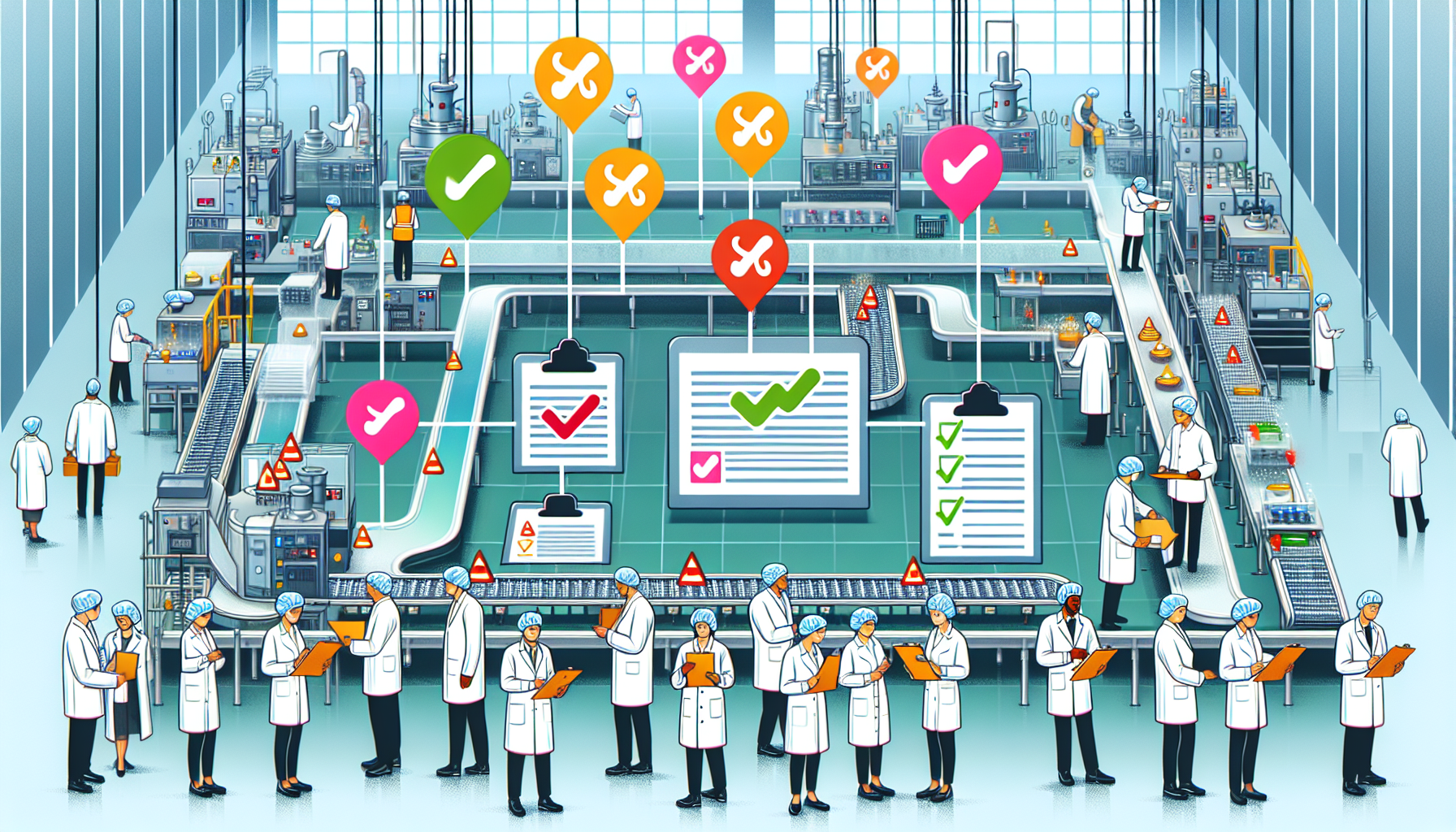Short Answer:
Manufacturing regulations ensure product safety, environmental stewardship, and quality. Vital for operational efficiency & risk mitigation, they cover OSHA safety, EPA environmental protection and quality control. With evolving requirements, manufacturers must navigate safety, environmental, and quality laws to uphold industry excellence and consumer trust.
Introduction & Background
As an attorney with over a decade of experience in venture capital, mergers and acquisitions, and private equity transactions, particularly with a focus on digital assets and cryptocurrency, my expertise extends into the critical understanding of regulatory compliance and its impact on operational efficiency and business reputation. This deep-rooted understanding places me in a unique position to explore and elucidate the multifaceted domain of manufacturing regulations, a cornerstone for any manufacturer striving for excellence and sustainability in today’s competitive landscape.
My tenure in advising leading entities on securities regulation and exchange compliance, combined with my experience in handling significant litigation for high-growth technology companies, underpins my authority on the subject. This backdrop of legal and regulatory expertise, especially in areas closely aligned with manufacturing’s evolving digital and technological frontiers, provides me with a unique lens through which to view and interpret the complex interplay of safety, environmental, and quality control regulations in manufacturing.
Key Takeaways
-
Manufacturing regulations are essential to ensure the safety of consumers and the environment, affecting all areas from operational efficiency to raw material requirements.
-
Regulatory agencies like the FDA and EPA play critical roles in establishing and enforcing manufacturing regulations to protect public health and the environment, with authority to conduct inspections and impose penalties for non-compliance.
-
Comprehensive supply chain management is crucial for manufacturing regulationx compliance, which involves careful supplier selection, continuous monitoring, and adherence to Good Manufacturing Practices (GMP) throughout the production process.
Understanding Manufacturing Regulations
Manufacturing regulations are an intricate web of guidelines that businesses must adhere to, ensuring safety, environmental protection, and quality in their operations. From the machinery needed for production to material requirements, every aspect of the manufacturing process, including manufacturing requirements, is regulated. The purpose is simple yet profound: to ensure that manufacturers produce goods that are safe for consumers and friendly to the environment.
Adhering to applicable specifications and regulations is not a mere formality. It is a critical factor in maintaining a company’s ability to uphold operational efficiency, the reputation of the business, and mitigating potential risks. Understanding and adhering to key requirements, such as these regulations, is a cornerstone for any manufacturer striving for excellence in the industry.
To fully grasp the breadth of manufacturing regulations, we need to delve into three major categories, namely safety regulations, environmental regulations, and quality control standards. Each of these categories is essential in their own right, and together they form the backbone of a good manufacturing practice.
Safety Regulations
When we think about manufacturing, one of the first things that comes to mind is safety. It is a paramount concern, not just for the workers involved but also for the end consumers. This is where OSHA steps in. Established in 1970, OSHA has been at the forefront of ensuring safer working conditions, contributing to a significant decrease in work-related fatalities.
OSHA’s safety requirements cast a wide net, covering several aspects from equipment safety to the use of personal protective equipment (PPE). It even extends to the presence of guard and lockout devices during machine operation and maintenance, ensuring that every stage of the manufacturing process is safe for the workers involved.
However, it doesn’t stop at establishing rules. OSHA also mandates employers to keep detailed records of employee safety training and accident reports. Certain types of incidents must be reported to OSHA, promoting transparency and accountability. This comprehensive approach to safety ensures that every manufacturing process is not just efficient, but also safe.
Environmental Regulations
While safety regulations prioritize human welfare, environmental regulations focus on the planet’s future wellbeing. Environmental manufacturing regulations are laws or incentives aimed at protecting the environment by:
- Controlling the use of certain substances
- Setting emissions standards
- Reducing waste
- Controlling machinery use
The goal is to ensure that manufacturing processes, overseen by manufacturing engineers, don’t harm the environment.
These regulations are enforced at both state and federal levels by agencies like the EPA through inspections, permits, and compliance measures including fines, penalties, and criminal charges. It’s a comprehensive system that ensures manufacturers are held accountable for their environmental impact.
Several key environmental regulations impact manufacturing operations. These include:
- The Clean Air Act
- The Clean Water Act
- The Endangered Species Act
- The Resource Conservation and Recovery Act (RCRA)
Each of these acts addresses different aspects of environmental protection, from air quality to waste management, ensuring a holistic approach to environmental conservation.
Quality Control Standards
Quality control is a critical aspect of manufacturing. It ensures that products consistently meet set specifications and standards. Effective quality control addresses product complaints and takes necessary precautions to prevent contamination in manufacturing, thereby ensuring customer satisfaction and trust.
Quality control is not just about adhering to set standards. In cases where standard methods are modified or when reference standards are not available, it’s critical to pay special attention to the key points of detailed procedures to maintain quality consistency.
Even the handling of rejected dietary supplements requires stringent quality control. These supplements must be clearly identified and controlled to avoid mixing issues, contributing to the assurance of the end product’s quality.
This meticulous attention to detail ensures the overall quality of manufacturing processes and, ultimately, the products that reach consumers.
The Role of Regulatory Agencies

While understanding manufacturing regulations is crucial, it’s equally important to comprehend the role of regulatory agencies in enforcing these regulations. Agencies like the FDA and the EPA play a primary role in this regard, ensuring industry and system-wide compliance.
These agencies have the authority to establish regulations for various classes of products to ensure the protection of public health. For instance, the FDA is responsible for making sure that food, drugs, and other health-related products are safe for consumption and use. On the other hand, the EPA has the power to enforce federal laws designed to protect the environment. This can include setting industry-specific regulations.
But their role doesn’t stop at setting regulations. Regulatory agencies have the authority to conduct inspections, audits, and reviews to monitor compliance with manufacturing regulations. They can utilize warning letters, fines, and even request recalls or product withdrawals if a company fails to comply with regulations.
FDA and Pharmaceutical Manufacturing
The FDA plays an especially significant role in the realm of pharmaceutical manufacturing. Its regulatory framework, detailed in Title 21 of the Code of Federal Regulations, includes requirements across several sections such as:
- Parts 210
- Parts 211
- Parts 212
- Parts 314
- Parts 600
The FDA’s GMP compliance is crucial in pharmaceutical manufacturing & manufacturing regulations as it guarantees the finished products are safe, pure, and stable. This prevents contamination, deviations, and errors, and in turn, ensures that patients receive drugs of high quality and at the correct dose.
To ensure this level of compliance, the FDA conducts global inspections of pharmaceutical manufacturing facilities. These include both facilities that produce active ingredients and those that provide finished drug products. Following an inspection, pharmaceutical firms are obliged to render a comprehensive and timely reply to FDA Form 483 observations, preferably within 10 days, to mitigate legal and financial consequences and influence the FDA’s enforcement decisions.
EPA and Environmental Compliance
The EPA, on the other hand, focuses on environmental compliance within the manufacturing industry. One of its main responsibilities is to regulate emissions produced by the manufacturing industry to mitigate environmental pollution.
The EPA provides guidance to manufacturers to assess and reduce the environmental impacts of their operations, products, and supply chains. This guidance helps manufacturers align their operations with environmental regulations, ensuring that their processes are eco-friendly.
Additionally, the EPA also oversees waste management practices in manufacturing. This involves ensuring proper disposal and reduction of waste, further minimizing the environmental impact of manufacturing processes.
Supply Chain Management and Regulations

Navigating manufacturing regulations doesn’t end with the manufacturing processes itself. It extends to the entire supply chain, from the selection of suppliers to the delivery of the finished product. Effective supply chain management is crucial for maintaining both financial integrity and regulatory compliance.
Supply chain management ensures that suppliers meet legal, ethical, and operational standards, along with buyers’ requirements. This is key in reducing risks like supply chain disruptions, regulatory fines, and reputational damage. In essence, effective supply chain management helps to ensure that all stages of the manufacturing process, from sourcing raw materials to delivering the finished product, adhere to the required regulations.
The EPA’s take on environmental regulations involves scrutinizing the full product life cycle from sourcing to disposal. This places added importance on manufacturers to manage specific ‘hotspots’ related to their product categories within the supply chain.
Supplier Selection
The first step in supply chain management is supplier selection. This involves:
- Establishing clear requirements and standards in terms of compliance with legal, ethical, and operational expectations, including the materials required
- Evaluating a supplier’s financial stability and compliance history to ensure adherence to applicable regulations and quality standards
- Especially crucial in industries like pharmaceuticals, where suppliers must comply with internationally recognized Good Manufacturing Practices (GMP)
But the process doesn’t end at selection. Continuous improvement with suppliers is crucial. This involves performance improvement plans, corrective actions, and collaboration on sustainability, quality, and efficiency initiatives.
Monitoring Compliance
Once suppliers are selected, the next critical step is monitoring compliance. This involves conducting regular internal audits and using specialized software to track supplier adherence to regulatory standards.
Quality audits are vital for assessing the compliance of suppliers with industry regulations. They evaluate the supplier’s quality systems and adherence to contract terms and regulatory requirements. This is a proactive approach to ensure that suppliers maintain the required standards and fulfill their contractual obligations.
But what happens when suppliers don’t comply? Consequences for supplier non-compliance include established penalties such as contract termination, fines, or legal action. This ensures that suppliers understand the importance of adhering to regulations and strive to meet the set standards.
Implementing Good Manufacturing Practices (GMP)

Good Manufacturing Practices (GMP) is a system designed to ensure that products are consistently produced and controlled according to established quality standards. It’s a crucial tool to minimize risks in the manufacturing process.
GMP is designed to avoid errors in the production process. These errors may include incorrect labeling or the incorrect amount of active ingredients. By adhering to GMP standards, manufacturers can ensure that their products are safe, reliable, and of high quality.
In specialized industries such as biopharmaceuticals, adopting GMP involves specific practices like:
- robust document control
- real-time monitoring to maintain thorough preparation for audits and inspections
- the use of technology, like ERP systems, to streamline product testing management, reduce errors, and enhance overall compliance.
Standard Operating Procedures (SOPs)
Standard Operating Procedures (SOPs) are an integral part of GMP. They provide clear guidelines for manufacturing processes, ensuring that each step is carried out consistently and accurately.
The implementation of effective SOPs requires them to be documented with clear and straightforward language. This ensures that all employees understand the procedures, reducing the possibility of misunderstandings and errors.
In effect, SOPs not only ensure consistent production quality but also adherence to regulatory requirements. This makes them an indispensable tool in the manufacturing industry.
Documentation and Record Keeping
GMP also emphasizes the importance of maintaining thorough documentation and records. These elements are crucial for ensuring product quality and safety. They ensure traceability of activities and overall quality evaluation. These records also provide proof of compliance during regulatory inspections.
ERP software aids in the traceability of manufacturing processes by tracking defect rates and production yields. This allows for early corrective actions, ensuring that the final product meets the required quality standards.
An inspection-ready binder should be created to house all key documents, ensuring they are easily accessible during an inspection. This organized documentation expedites the inspection process, allowing for a smoother and more efficient audit experience.
Technology Solutions for Regulatory Compliance

As we’ve discussed, adhering to manufacturing regulations involves a lot of moving parts. Managing all these elements manually can be time-consuming and prone to errors. This is where technology solutions step in, providing a more streamlined approach to regulatory compliance.
Manufacturing ERP systems are a prime example of such technology solutions, including computer systems. These systems are crucial for ensuring manufacturing regulations compliance within the industry. They offer features such as advanced quality management and integration capabilities for components that enhance quality control and operational performance.
But the benefits of implementing technology solutions extend beyond streamlining compliance processes. They can also lead to cost savings, enhanced risk management, and improved customer experiences. These systems use predictive analytics to identify potential compliance risks in real-time, offer advanced data analytics for better decision-making, and improve customer experiences through automation.
Manufacturing ERP Features
Manufacturing ERP systems come equipped with several features that assist in ensuring regulatory compliance. One of these features is advanced quality management, which ensures product compliance and meets regulatory manufacturing requirements.
Another crucial feature of these systems is their integration capabilities. With open APIs, ERP solutions can support third-party applications that enhance quality control and operational performance. This means they can be seamlessly integrated with other systems used in the manufacturing process, providing a comprehensive solution for regulatory compliance.
In essence, manufacturing ERP systems:
- Streamline the manufacturing process
- Ensure that the process meets all regulatory manufacturing requirements
- Aid in maintaining the high quality of the final product
- Ensure regulatory compliance
Benefits of Implementing Technology Solutions
Implementing technology solutions for regulatory compliance offers numerous benefits. For one, organizations can achieve cost savings by automating compliance-related tasks. This reduces the need for manual processing and personnel expenses, leading to significant cost savings.
RegTech solutions also enhance risk management by:
- Using predictive analytics to identify potential compliance risks in real-time
- Allowing organizations to proactively address these risks
- Preventing potential issues before they become significant problems
Moreover, implementing technology solutions can lead to improved customer experiences. By automating compliance processes, organizations can provide more personalized services and greater convenience to their customers. This can lead to increased customer satisfaction and loyalty, ultimately benefiting the business by addressing customer demand.
Training and Employee Awareness
Even with robust systems and processes in place, the human element remains critical in ensuring regulatory compliance. This is where training and employee awareness come into play. Employee compliance training ensures that staff understands and adheres to company policies and legal requirements, crucial for avoiding legal issues and penalties.
Proper employee training is essential for organizations to manage risks effectively. It helps protect their reputation and sustain trust with clients and stakeholders. In essence, training and employee awareness are not just about imparting knowledge. They are also about embedding a culture of compliance within the organization.
This involves not just one-off training sessions but a continuous process of learning and improvement. Employees should be regularly updated on:
-
changes in regulations
-
company policies
-
new technologies
-
processes that are implemented in the organization
Compliance Training Programs
Compliance training programs are a crucial aspect of this learning process. These programs should include engaging and interactive content that is tailored to organizational needs. They should also be regularly updated to reflect the latest laws and best practices, ensuring that employees have up-to-date knowledge.
Compliance training can encompass a wide array of topics, including:
- Healthcare regulations
- Workplace safety
- Diversity
- Data protection
In specialized industries like pharmaceuticals, the training may include specific elements as guided by the Office of Inspector General.
The delivery of compliance training is just as important as the content itself. Here are some key considerations:
- Training should be communicated in a clear, concise, and consistent manner.
- Support should be provided for suppliers to understand regulations.
- Post-training, continuous observation and effectiveness checks should be carried out to ensure long-term retention and adherence to learned behaviors.
Building a Culture of Compliance
Building a culture of compliance goes beyond training programs. It involves fostering an environment where compliance is viewed as a shared responsibility. This begins with leadership openly communicating the importance of regulatory compliance and demonstrating commitment by investing in employee training and continuous improvement.
A robust culture of compliance encompasses the collective values, attitudes, and behaviors within an organization that promote adherence to necessary compliance policies and regulations. In such a culture, every individual in the organization understands their role in ensuring compliance and is committed to fulfilling this responsibility.
To effectively sustain a compliance-focused culture, organizations should utilize tools designed to monitor, manage, and streamline compliance tasks and workflows. This ensures that compliance activities are carried out efficiently and effectively, further reinforcing the culture of compliance.
Preparing for Regulatory Inspections and Audits
An integral part of regulatory compliance is preparing for regulatory inspections and audits. These inspections and audits are conducted by regulatory agencies to ensure that organizations are adhering to manufacturing regulations. To prepare for these inspections, organizations need to maintain organized key documents and records.
An inspection-ready binder should be created to house all key documents. These documents should be easily accessible during an inspection, ensuring a smooth and efficient audit experience. Organizing documentation not only expedites the inspection process but also allows organizations to keep track of their compliance efforts. It provides a record of the steps taken to adhere to regulations and the progress made in improving compliance.
Inspection Readiness
Ensuring inspection readiness is a continuous process. It involves pre-audit data collection, a thoroughly organized preparation phase, the execution of the audit, and systematic follow-up actions.
To promptly address requests during inspections, follow these steps:
-
Clearly label all items.
-
Organize materials for swift retrieval.
-
Actively collaborate with FDA investigators during their facility visit to correct any inaccuracies immediately.
If immediate correction is not feasible, a written response should be provided promptly after the inspection concludes. This shows the organization’s commitment to addressing the issues raised during the inspection and its willingness to improve its compliance efforts.
Responding to Inspection Findings
Responding to inspection findings is a crucial part of the audit process. An effective response includes:
- Restating the observation from the company’s perspective
- Providing scientific reasoning
- Detailing corrective actions already taken
- Outlining preventive measures to prevent reoccurrence
Responses should be based on scientific evidence and maintain respect for the inspection process and the inspectors’ expertise. This shows the organization’s commitment to maintaining the highest standards of compliance and its respect for the regulatory process.
Non-compliance with CGMP as identified by the FDA can result in drugs being deemed adulterated. This designation does not imply immediate health risk but indicates regulatory non-conformance. This highlights the importance of promptly and effectively responding to inspection findings.
Summary
In conclusion, navigating the complex landscape of manufacturing regulations involves understanding these regulations, implementing good manufacturing practices, managing the supply chain effectively, and preparing for regulatory inspections and audits. It also involves fostering a culture of compliance within the organization and leveraging technology solutions to streamline compliance processes. While the journey is complex, with the right approach and tools, organizations can effectively navigate this landscape, ensuring the highest standards of safety, quality, and environmental protection.
Frequently Asked Questions
What is difference between cGMP and GMP?
In conclusion, the main difference between cGMP and GMP lies in their focus on current regulations. While GMP ensures general product safety, quality, and purity, cGMP emphasizes the latest quality standards to help companies comply with the most current regulations.
What are current good manufacturing regulations practices?
The current good manufacturing regulation practice, known as CGMP, are established by the FDA to ensure consistent production and control of products in industries like pharmaceuticals, food and beverage, medical devices, and dietary supplements. Adherence to these regulations assures the quality and purity of drug products by requiring proper design, monitoring, and control of manufacturing processes and facilities.
What are regulatory requirements in manufacturing?
Manufacturing Regulatory requirements include compliance with government regulations on safety, environmental impact, labeling, and product specifications. Non-compliance can result in legal consequences, fines, and reputational damage.
What is the importance of supply chain management in regulatory compliance?
Supply chain management is crucial for maintaining regulatory compliance as it ensures suppliers meet legal, ethical, and operational standards, reducing risks such as supply disruptions, regulatory fines, and reputational damage. Internal audits and specialized software help in monitoring compliance (Date not included).
How can technology solutions aid in regulatory compliance?
Technology solutions, such as manufacturing ERP systems, can streamline compliance processes and enhance regulatory adherence by offering advanced quality management and integration capabilities, for example, leading to cost savings and improved customer experiences.



